What I am doing here is what I am comfortable with, and feel that I can do safely. I do not recommend you attempt this if you aren't absolutely sure you can.
Our house still has the old electric floor heaters like the one below. There is one in the living room and one in the hallway that supplies heat to the entire house, which is two stories tall. After last winter, and seeing the electric bills, I decided to go with baseboard heaters in each room to maintain the comfort level. The rooms were all over the place as far as temps go, and I want to try to even them out by installing baseboard heaters in each room. Until we can afford to install central heat and air, these new baseboard heaters will have to do.
 |
| Old 240 volt electric floor heater |
I want to give a quick bit of information about the heaters and how I sized them for each room. I have five 30 amp, 240 volt circuits available to me. These are old circuits that were used before we got the house to run space heaters and window air conditioners. I left all the wall outlets in their original locations and ran new wire to them when we
rewired the house in this blog . I ran all new 10 gauge wire to them which will allow a maximum of 5760 watts per circuit as stated by the heater manufacturer. They also recommend an old house like mine, which is insulated well, to use 10 watts per square foot of room space as a guideline for sizing the heater(s). There are a lot of variables involved when sizing the heater for a room, so check with the manufacturers, they have lots of charts and other useful info. The largest room I have is the master bedroom which is 384 square feet, so I will need 4000 watts, followed by the living room which is 247 square feet, or 2500 watts. Here in the dining room I have to heat 110 square feet. I went with a 1500 watt heater because it was an in stock item at Lowes. I could have special ordered one that was 1250 watts, which would have done the job, but I didn't want to wait and figured another 250 watts couldn't hurt.
Fahrenheat makes heaters from 500 watts to 2500 watts, and the Lowes store in my area carries some of them in stock.
The manufacturer recommends installing the heater under a window. This is because the cold air dropping from the cold window creates a convection current and circulates the air. Here is a diagram I found that helps explain the current.
 |
| Convection current explained |
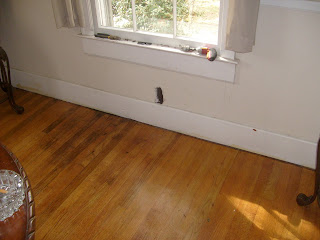 |
| Location selected for dining room baseboard heater |
The hole in wall is where a 240 volt receptacle was for a window air conditioner. I removed the outlet and box, then pulled the wire from the breaker box down into the basement. I marked the location of the 72 inch heater centered on the baseboard under the window.
 |
| Fahrenheat 1500 watt electric baseboard heater |
I unboxed the heater and removed the covers on the ends to gain access for wire connections and mounting to be done later.
 |
| Fahrenheat 1500 watt electric baseboard heater |
Each heater requires it's own thermostat, and they DO NOT come with them. Your choices are either a unit mount or a remote wall mounted thermostat, and both have their pros and cons. The unit mount thermostat fits on either end of the heater and does not require running any additional wire so they are easy to install. They also cost more than wall mounts (about $8 here). A wall mount thermostat should be located on a wall opposite the heater and does requires you to run extra wire. 50 feet of 10/2 wire was about $50, so that needs to be factored in. I copied this from the Cadet website,
" Is an in-built or a wall mount thermostat better? An in-built control is convenient to install when the walls are already finished. However, a wall thermostat is a more accurate way to control the room temperature, is more convenient to use, and has a broader selection of models.".
I went with a remote thermostat because it seemed logical to me that a wall mount would maintain the temperature better and we wouldn't have to bend over or get behind something that may be blocking access to the thermostat if it was mounted on the heater. I selected a location opposite the heater 5 feet from floor as recommended by the manufacturer. I chose this spot because it was out of the way and wouldn't stick out like a sore thumb.
 |
Hole cut out for outlet box that will house the thermostat
|
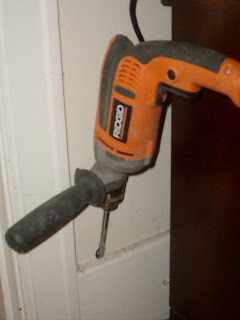 |
| Drilling holes for wires |
On the opposite side of the wall from the outlet box hole cut above I used a
16 inch spade bit to drill two holes, one for the feed wire from the circuit breaker box and one that goes to the heater. Notice the angle of the drill? I found that there was a doubled floor joist under here and the angle was necessary to clear it so I could pull the wires. I drilled two holes through the floor from this one small hole by leaning the drill to the right slightly. The hole itself can be easily patched later.
 |
| Remodel outlet box |
This is what I call a remodel box. Notice the silver screws? They are attached to small wings that rotate around and tighten to secure the box in the wall. They are nice because they can be located anywhere on a wall and don't need a stud to fasten it to.
 |
| Installed outlet box with wires installed |
Here I have pulled the wires from the basement with a
fish rod and installed the outlet box where the thermostat will be located. The wire on the left is from the breaker box, the one on the right is to the heater.
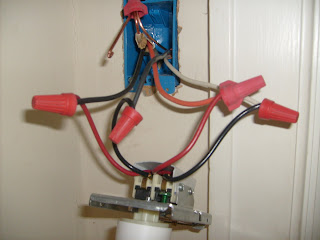 |
| Thermostat wiring connections (ground wire left off for clarity) |
I must admit that I can't read electrical schematics very well and that's all they had in the instructions for installing the thermostat, so I found these instructions in a discussion forum. Evidently I wasn't the only one!
Looking at the back with the knob at the bottom.
"The Black Wires from the md26 are your load(the heater) and the red lines are your line(power). The lines are also paired up on the thermostat with a red and black on the left and are red and black on the right.
In the actual heater connect the black to the black wire and the white to the white and connect the grounds.
In the thermostat connect the black from the heater to left side black( remember there are pairs left(black, red) right (black, red) and the white to the right side black.
Connect the black from your power to the left side red and the white (red in my case) from your power to the right side red. Should be ready to go."
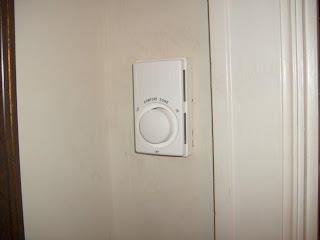 |
| Thermostat installed |
 |
| Wire from thermostat coming up from the basement |
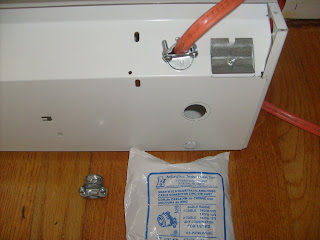 |
| Knockout removed and wire installed |
Here I removed the wrong knockout (see open hole) and then removed the correct one. I used a snap in type romex clamp to secure the wire in the heater. I like the snap in type connectors because, to me, they are easier to install than the other type with the nuts.
 |
| Heater wire connections |
The electrical connections are made here and the baseboard heater is secured to the wall with a couple of drywall screws (black screws) on each end. I left myself some extra wire behind the heater that I pushed back down into the basement. I did this in case I ever need to pull the baseboard heater away from the wall to paint.
 |
| Installation complete |
All in all, I thought this was an easy job. It only took me a couple of hours, but I already had wire run from the breaker box, and easy access in the basement for running the new wires. Here is what it cost:
1500 watt heater $54
240 volt thermostat $19
50 feet 10/2 wire $50 (I used about 20 feet on this heater, the rest I will use on the living room heater)
Labor 0$


















